B2B Lead Generation: What It Is, Examples & Strategies
Who doesn’t like having new customers and qualified leads, right? However, no matter how outstanding and one-of-a-kind your product is, people won’t just buy it on the spot, especially if you’re selling to businesses.
B2B lead generation is a complicated process that involves marketing and sales activities aimed to expand your customer base. You can’t neglect it if you want to increase revenue and build brand awareness.
So, what does it take to create a successful strategy that brings high-quality B2B leads?
Our guide covers everything you need to know about B2B lead generation.
Let’s dive in.
What is B2B Lead Generation?
B2B (business-to-business) lead generation is a process of finding and attracting potential buyers for your product or service. The target audience, in this case, includes decision-makers in companies and organizations.
In our Lead Generation Guide, we’ve mentioned that it deals with converting strangers into potential customers, but that’s a general definition. B2B lead gen is about the same, but you’re dealing with a different kind of audience, and it means using a slightly different approach (we’ll talk about it a bit later).
Now, what does generating leads for B2B look like in practice?
There are many ways to attract prospects, but just as a general example, take a look at this report by HubSpot, a well-known marketing and CRM solution:

What we see here is gated content, meaning that to access it, you need to share some personal information (first name, last name, email, phone number, company name, company size, website).
The report itself provides valuable statistics on different digital marketing strategies, updated for 2021. It clearly presents immense value to HubSpot’s target audience, so why not use it in marketing campaigns? The prospect gets access to unique data andHubSpot acquires a lead.
B2B lead generation vs. B2C lead generation
Overall, the principles of lead generation work equally both for B2B and B2C companies. However, there are still quite a few differences you need to know about to differentiate these two strategies.
Take a look.
B2B lead generation
- A longer sales cycle. It takes longer for a company or organization to make the purchase decision, so the buyer’s journey, in this case, is longer and more elaborate.
- A more in-depth content strategy. B2B buyers are often more demanding and need reassurance that they are making the right choice by buying your product. That’s why B2B lead generation usually involves in-depth content such as case studies, reports, infographics, etc.
- A specific audience. B2B leads are often limited to company management, so the circle you’re targeting is usually smaller.
- The goal is to sell through building a long-lasting relationship. B2B businesses focus on establishing a strong connection with a buyer before selling.
- Limited social media marketing opportunities. In terms of lead generation, only LinkedIn, Twitter, and (maybe) YouTube have real value for B2B companies.
B2C lead generation
- A shorter sales funnel. Transactions in B2C are usually much shorter, and purchase decisions are made faster. In other words, a potential client comes to your website, sees the product, and claims it (if it fits their needs).
- Content used primarily at the buying stage. Even though B2C buyers also do research before purchasing, it usually does not take a lot of time. That’s why marketers often target such leads with promotions, coupons and other content at the buying stage of the sales process.
- A large audience. In B2C, everyone is a potential customer, and the target audience is much broader than in B2B.
- The goal is simply to sell. B2C businesses are usually striving to sell a product (usually in a highly competitive market), and that’s it.
- Broader social media marketing opportunities. Sky’s the limit for B2C companies – they can advertise their products successfully on all social media channels (except for maybe LinkedIn).
We’ve also prepared a graph to make it easier for you to navigate the differences between B2B and B2C lead generation:
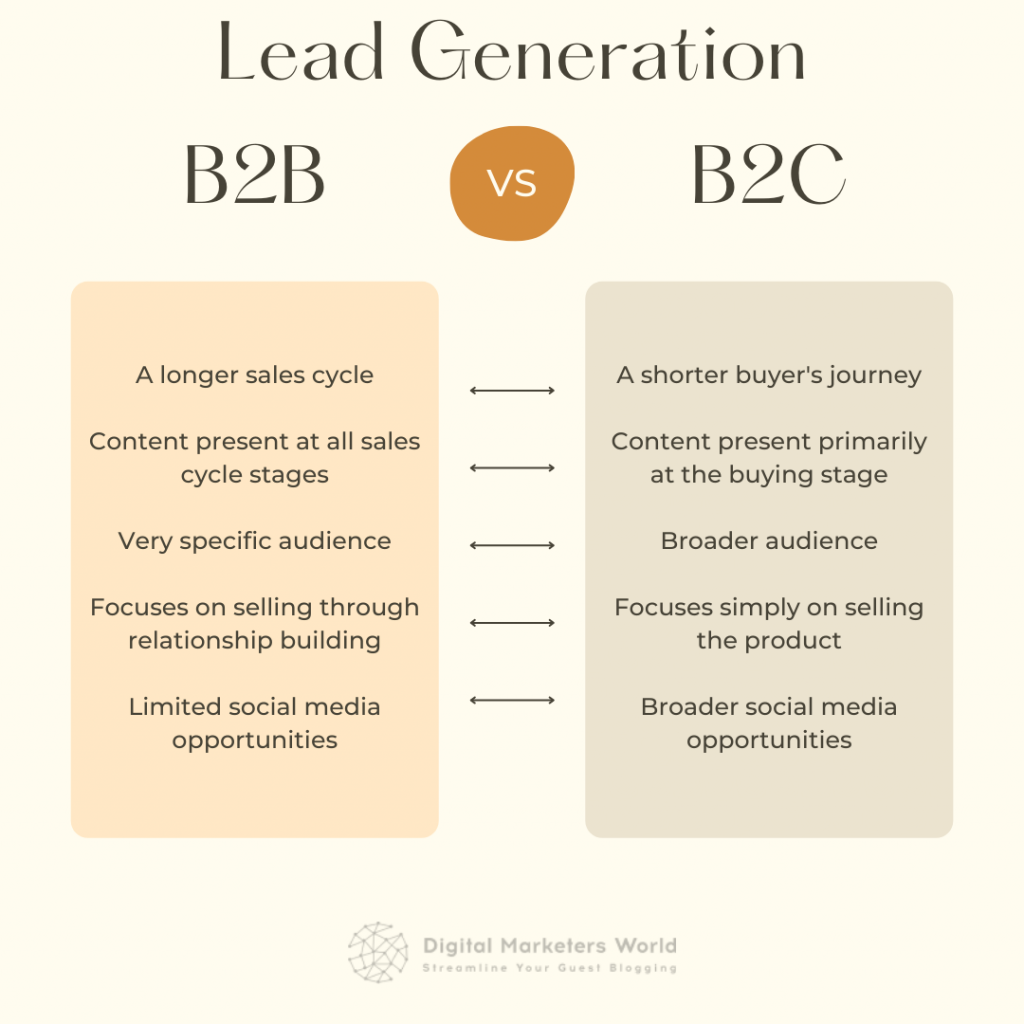
So, to sum up, the sales cycle in B2B lead generation is more involved, requires more content to convince potential customers, deals with a more specific audience, and strives to attract them through building a lasting relationship.
Why Does B2B Lead Generation Matter?
It’s partially true that the B2B world relies a lot on word-of-mouth. A business can theoretically get new customers if the existing ones spread the word. However, it’s unwise to rely on that.
You need lead generation because it makes your brand more discoverable. That’s the reason why this strategy is in the top five marketing activities, according to HubSpot’s report that we mentioned in the example above. Besides, almost 35% of B2B marketers said generating leads was their main focus in 2021:
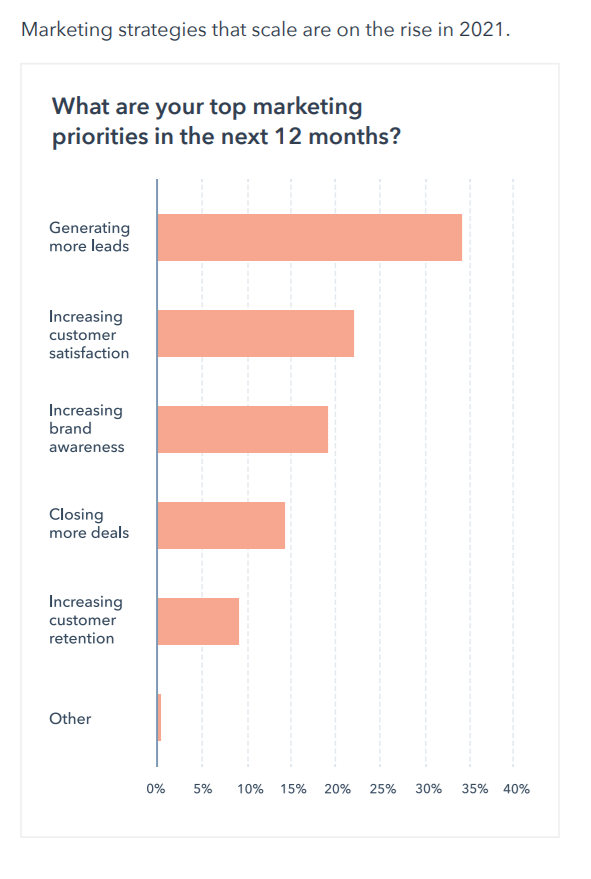
What are other reasons to incorporate lead generation in your digital marketing strategy besides the fact that everyone is already doing it?
Let’s take a look.
- Increasing brand awareness. As we mentioned, lead generation activities make your online presence known to more people. Essentially, you use various channels and lead magnets to increase your visibility and reach potential buyers.
- Outrunning the competition. There is hardly any niche in B2B where you won’t find competitors. If you don’t do lead generation, they will swoop in with better offers and value propositions and steal prospects from you.
- Educating potential customers. Lead generation is not just about attracting prospects and collecting their contact information. It is also about educating and convincing them that your solution is better than what your rivals have to offer.
- Facilitating growth. If you want to expand your business, generating demand is an absolute must. There is no other way to let more people know about your product.
Indeed, the main goal of B2B lead generation is to improve sales and increase profits. However, you also need to look past money and understand that generating leads is also about building trust. Remember that relationship building is essential in attracting B2B leads.
Besides, regardless of your company’s size, you need to understand that information is crucial in generating potential buyers. The decision-makers in B2B often do elaborate research before making the final purchase decision.
That’s why the more resources you give them to learn more about your brand and product, the better. Prospects should see you as an authority and a thought leader in your niche and industry. If you bet on educating rather than pushing people to buy, you are guaranteed to attract more buyers.
6 Inspiring B2B Lead Generation Examples
Now, let’s consider more examples of B2B lead acquisition and discuss what makes them special. This section is about inspiring you to follow the best practices, but also helping you learn how to find your unique approach to prospects.
At this point, we’d like to remind you that every lead generation campaign involves the use of lead magnets. You can find more examples of those in our article.
Let’s head over to B2B lead strategy examples.
Example #1: ProfitWell
Profitwell is an example of a well-rounded approach to lead generation. The brand uses various techniques to generate leads by offering real value.
For instance, its service called Recur, dedicated to breaking down the trends and news in the marketing world to help businesses drive subscriptions, uses many tactics to attract leads.
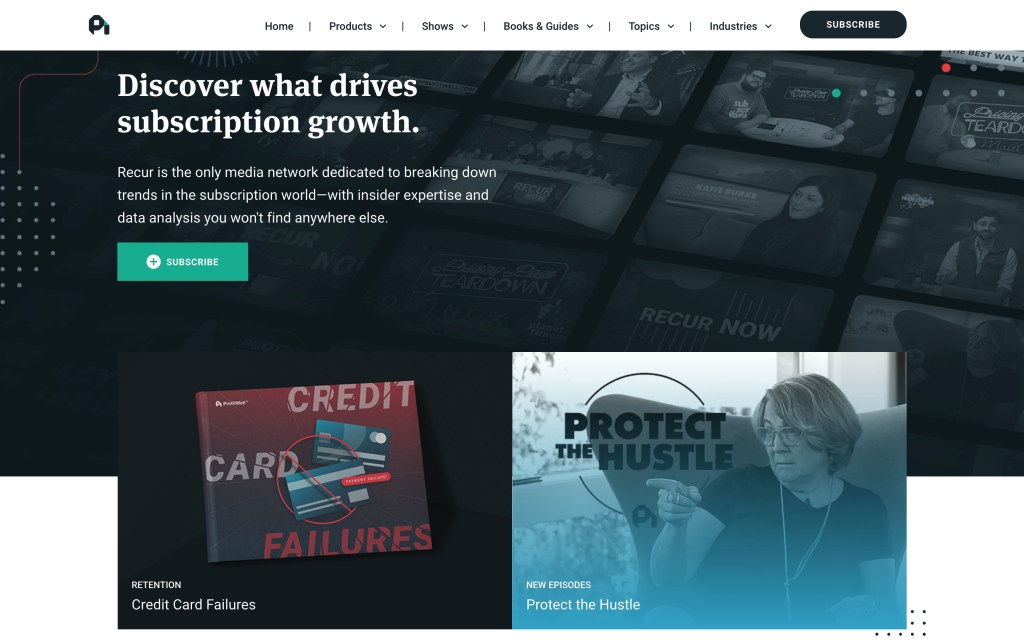
If you visit the page above, you can see that there are regular subscription call-to-actions as well as a case study about reducing churn from failed payments, a podcast discussing B2B SaaS growth strategies, books, and guides you can download after providing your name and email address.
The ProfitWell blog also has a subscription form that accompanies you while you read the post:
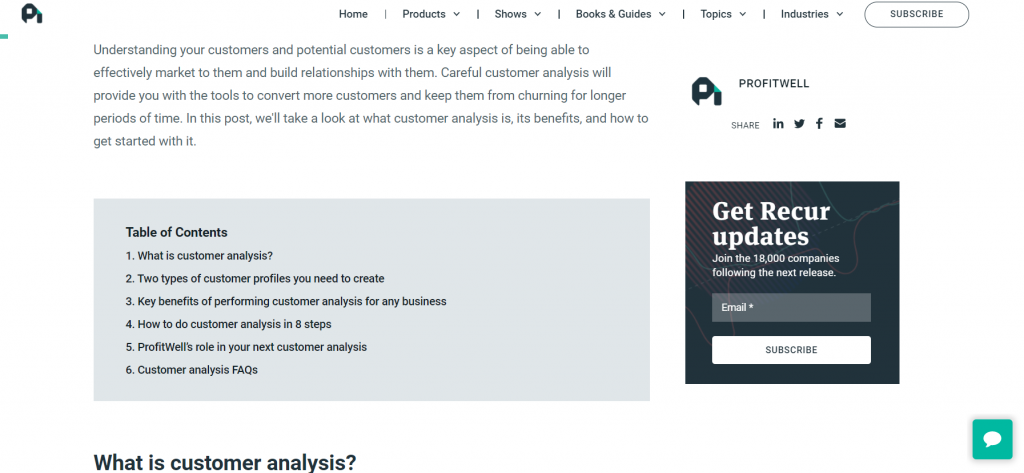
So, if you like the piece, you can subscribe to get more updates and receive news regularly on your email.
What’s so good about this lead generation strategy?
First of all, it looks very organic. ProfitWell doesn’t push the prospects to subscribe or download their content. You can even access some of it for free. However, to get more in-depth insights, you need to provide personal information in exchange.
It is also important to note that ProfitWell doesn’t clickbait the prospects. Some brands are guilty of that: they promise high-quality content and instead send something that is hardly usable.
So, the main lesson here is, if you use content for lead generation, prompting people to subscribe and share their contacts, offer something truly valuable and one of a kind in return.
Example #2: Hootsuite
Among all inbound content marketing tactics, case studies probably drive the most value in terms of bringing new leads to your business. They tell real customer success stories and prove that your product or service, in fact, works.
Should you gate all case studies in an attempt to get more prospects?
Definitely not. Choose the ones covering the topics that are currently the most topical for your target personas. Take Hootsuite, for instance. The company uses a particular case study to show how its solution in combination with the focus on customer experience has helped achieve positive results for Careem, a mobile app:
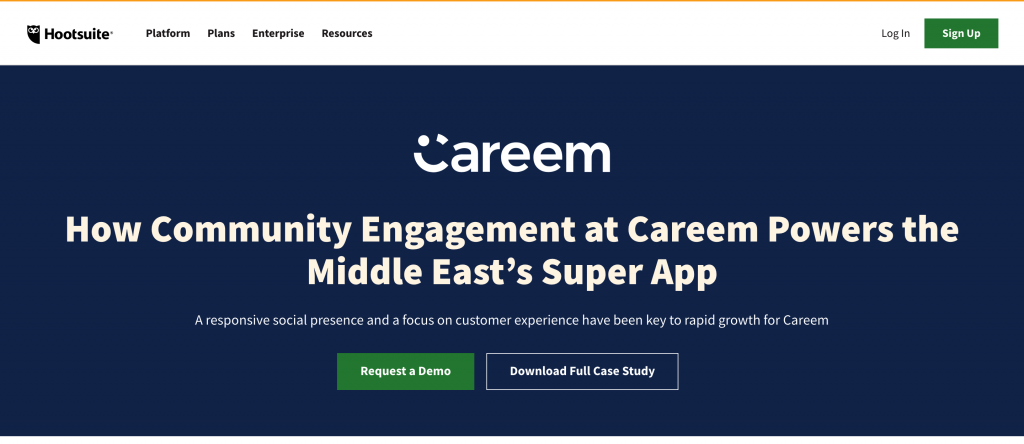
Hootsuite also added the Request a Demo CTA to encourage people to book a meeting with the sales reps if the case study happens to convince them that Hootsuite’s solution is the right one for them.
At the same time, all other Hootsuite’s case studies are in free access on its website:

How often should your marketing teams produce case studies?
Not too often, otherwise, they lose their value. After all, this type of content requires thorough research and data collection, so take your time.
It’s also an excellent idea to reuse case studies in PPC ads. You can either create a banner with a call to action retargeting website visitors, or invite your clients to share their success stories in a video.
Example #3: Higher Visibility
Content is not the only way to get more people interested in your brand and product. It’s also a good idea to invest in free-access tools and use them to generate leads.
Take Higher Visibility, for example. Its website has a library of free marketing solutions helping you solve specific SEO-related needs:
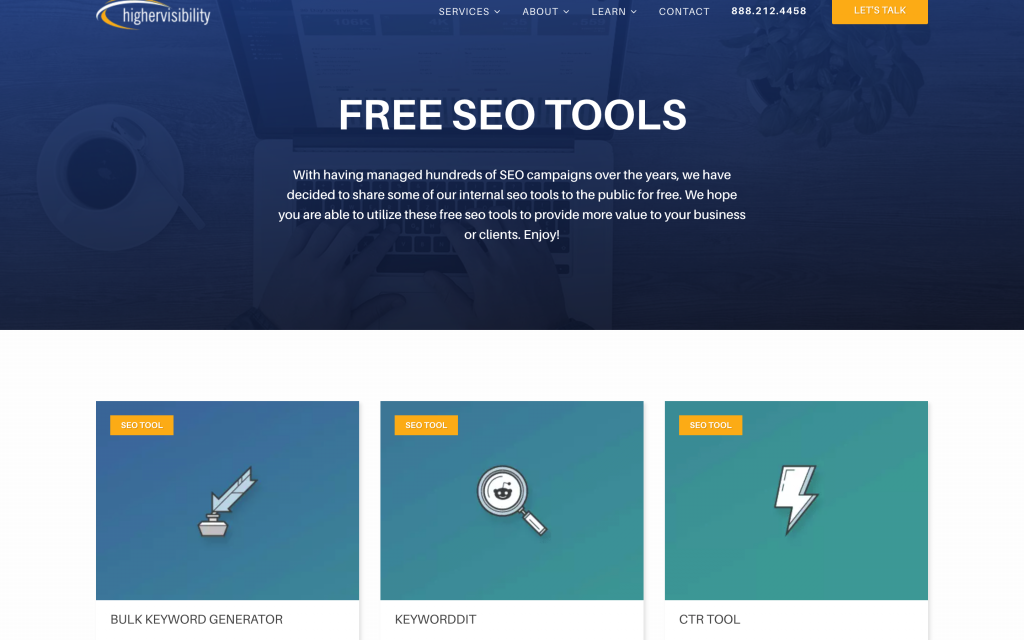
Let’s click on the CTR tool – it helps you choose the right keywords for the title tags to drive the click-through rate, conversion rate, and improve traffic. All you have to do is enter your five primary SEO keywords. However, to get the result, you first need to subscribe. Higher Visibility uses pop-ups like this as subscription forms:

A collection of free tools is a way to show and prove your value to a potential customer. When you see that a person has subscribed to your free tool, you can nurture them by redirecting to landing pages, where they can learn about the full functionality of your product.
Note: it’s crucial to do some A/B testing for your free tools to make sure they indeed cater to your target audience’s needs.
Example #4: Viral Loops
It’s always a good idea to organically implement your lead generation efforts into your current content marketing strategy. For instance, you can write a guest post and show how your free tool can solve a particular problem.
If you’re looking for a real-life example of this tactic, consider Viral Loops. For instance, in the article about calculating customer acquisition costs, the brand offers their CAC calculator to make the job easier:
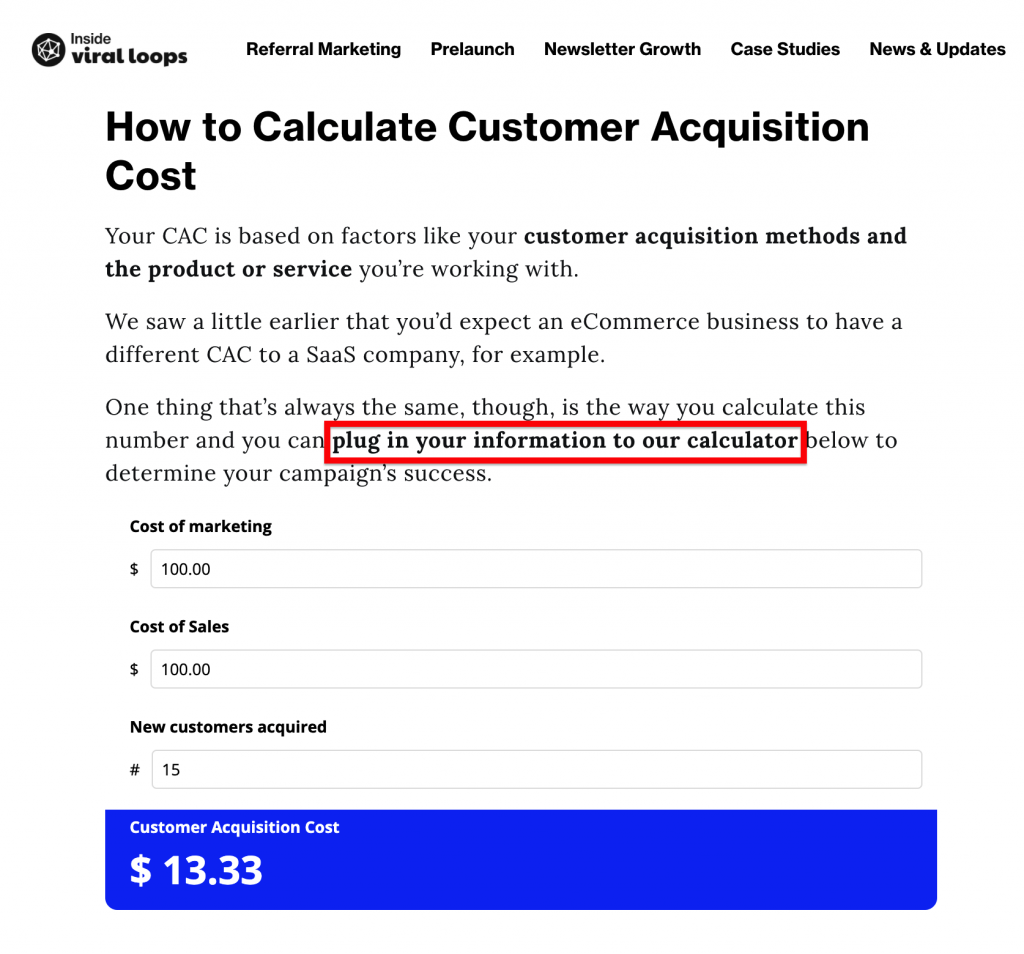
Instead of the free tool, you can also offer a template, a cheat sheet, workbooks, toolkits, and other lead magnets. Here’s an example of a template included in a guide on the Viral Loops blog:
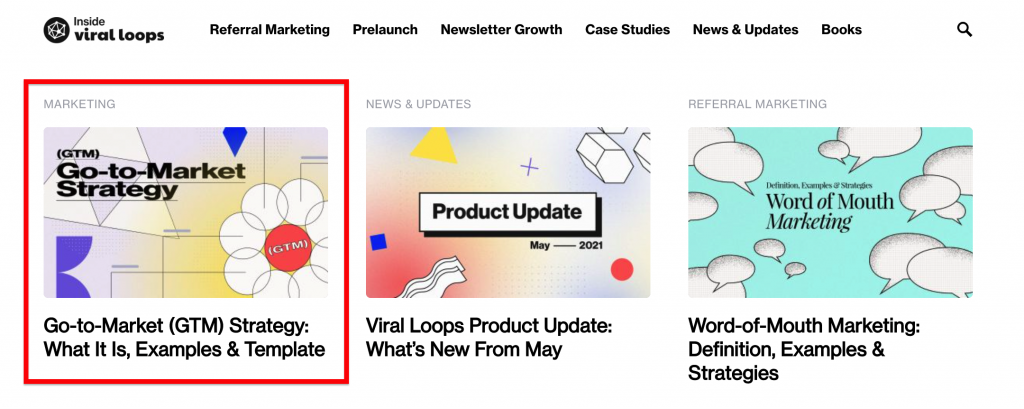
When you click on the template, the subscription form appears, asking you to provide contact details:
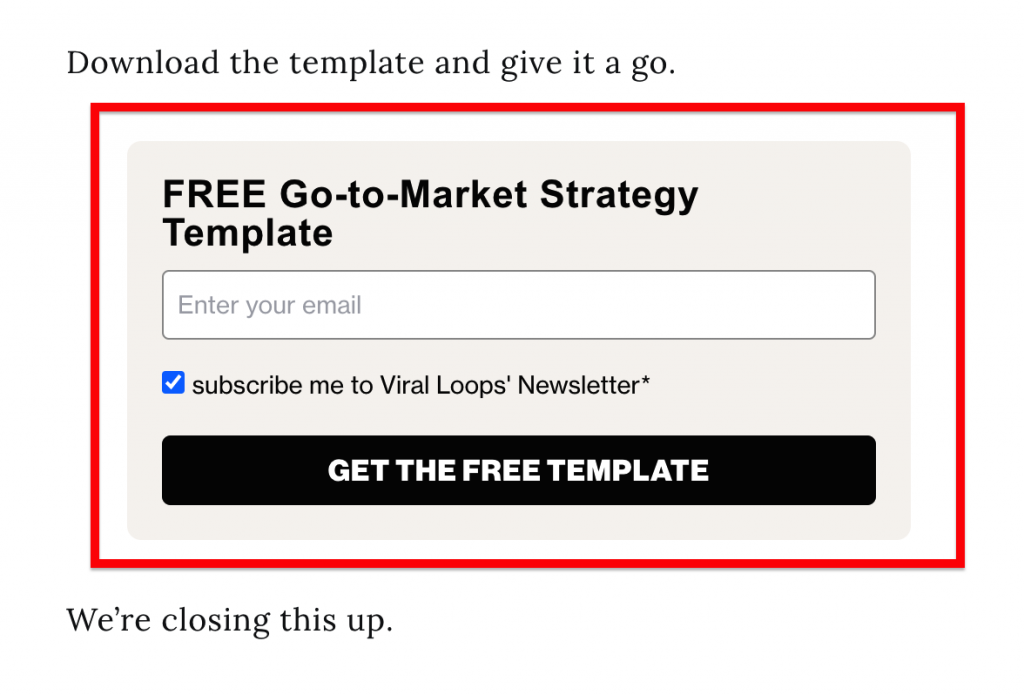
The main point here is to try and integrate your lead generation efforts seamlessly. Remember – you want to educate, not impose your product on potential prospects.
Example #5: Clearbit
If you want to get more potential leads and strengthen your authority in the industry, you can create entire libraries and turn part of your website into an educational hub.
Again, some of the resources in your library can be free, and some (more recent ones) can be gated. Take this example from Clearbit, for instance:
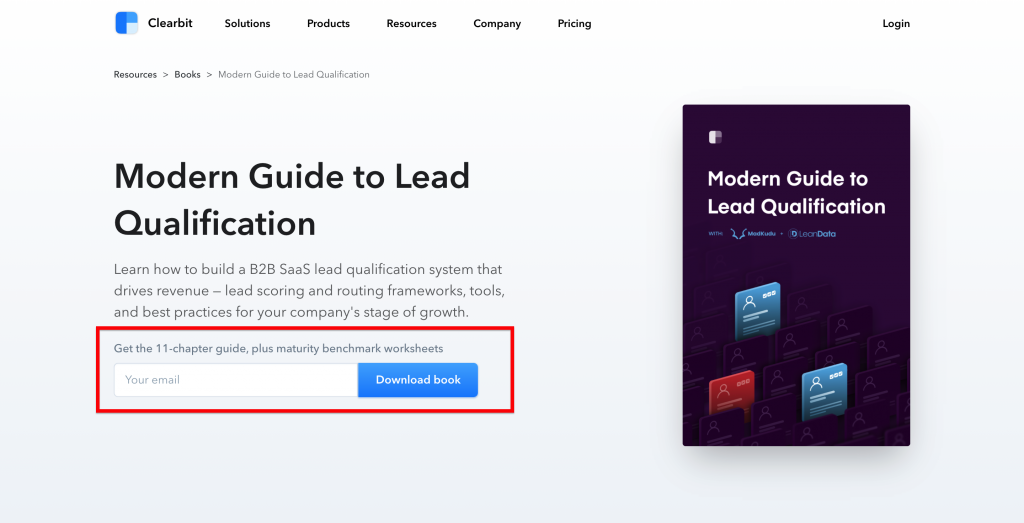
It’s an 11-chapter lead qualification guide that you can download along with other books from the Clearbit website. The brand’s library also contains whitepapers, case studies and free tools which it uses to generate leads.
Example #6: SEMrush
We’ve talked mostly about blog resources in the previous examples, but you can also successfully use webinars to attract B2B prospects.
Take SEMrush, for example. It has a few upcoming webinars, and to get access, you need to provide contact information:

The brand also has all its past webinars in the library, which you can access without a subscription. Apart from that, online video content is available in different languages, including Spanish, French, German, Portuguese, etc.
If you’re inviting people to participate in your webinar, make sure it carries value. This is a rule of thumb in B2B lead generation – you should be mindful of the need you’re trying to solve with your content, and all your efforts should be aimed at living up to the target customer’s expectations.
4 B2B Lead Generation Strategies that Work
Now, on to the most important part of our guide – the tactics that will improve your B2B lead generation processes. We’ll take a look at five essential tips that businesses sometimes miss or disregard.
We’ll also share a few examples to illustrate our points better. But remember – at the end of the day, it’s all about representing your uniqueness. So, draw lessons but don’t copy.
Strategy #1: Focus on content marketing
Content is necessary in sales funnel optimization, and it can make or break your lead generation efforts. That’s why you should pay attention to it from the start.
What makes engaging B2B content?
These are just a few essential elements:
- Actionable – delivers practical information that expands the reader’s knowledge and can be applied in practice.
- Reliable – shares data that can be fact-checked.
- Easy to consume – is written in clear language, not using too much professional jargon (or at least explaining it along the way).
- Reusable – you can repurpose it in an ads campaign or promote it on social media platforms.
- Convincing – provides enough value for the lead to consider buying your product.
- Up-to-date – covers the most recent trends in the industry.
The content that possesses all these characteristics is way more likely to deliver qualified leads. After all, when you have something unique to offer, more people will want it if it caters to their interests.
An example?
Consider Gong.io. It’s a solution that analyzes customer interactions and provides data-based insights to improve B2B sales. The brand has created the Revenue Intelligence Content Hub, where it shares gated guides, case studies, checklists, webinars, templates, etc.:
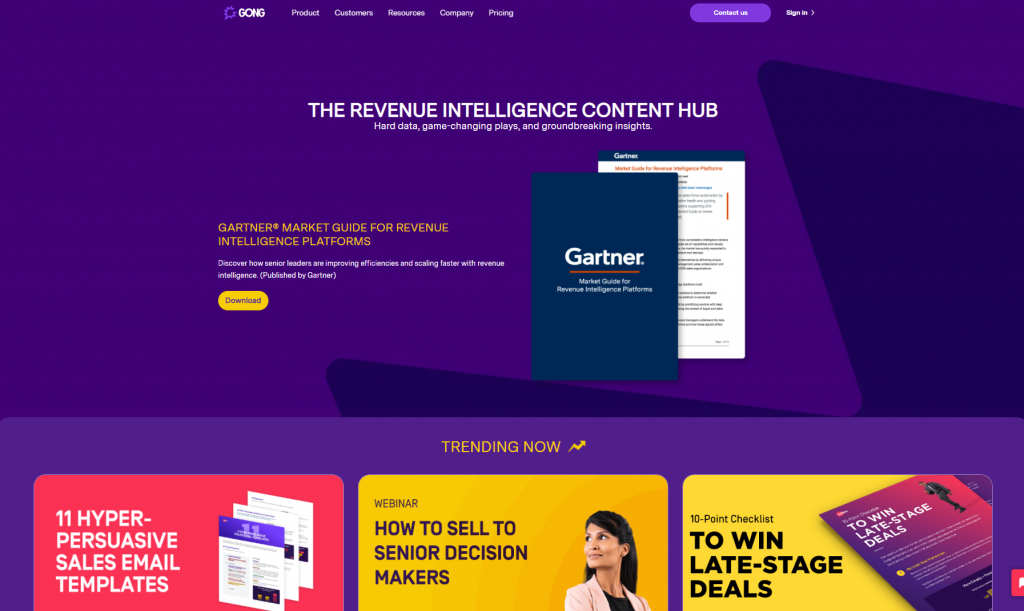
Gong has all the material in one place, making it easy for potential customers to browse this information and see the value the brand tries to deliver. Also, notice how Gong bets on educating the leads through studies and data. This is definitely a step in the right direction, establishing the brand’s authority in the industry.
At this point, it is important to reiterate that a smart marketing strategy in B2B always bets on information. Your prospects need more resources to make a weighted decision.
Strategy #2: Elevate your email outreach
Many companies use email marketing in pursuit of high-quality leads. Email outreach is also a good outbound strategy (much like cold calling) for startups and small businesses – it can deliver a high ROI at a relatively low cost.
There’s one thing, though – the vast majority of such emails are ignored.
According to the 2019 study by Backlinko, only 8.5% of outreach emails are discarded. Obviously, most people simply are not interested or don’t want to reply to a message from a stranger due to the fear of getting spammed.
So, does it mean you shouldn’t do outreach to generate leads?
Of course not. Emails are still a viable tactic to attract prospects; you just need to know how to approach it. Backlinko’s study we mentioned earlier happens to have a few useful tips:
- Try writing longer email subject lines. Such emails have a 24.6% higher response rate.
- Personalize your subject lines. It increases the number of replies by over 30%.
- Follow up. It will bring you two times more replies.
- Find several contacts within one organization. If you send a message to several decision-makers and their referrals, it will increase the response rate by 93%.
- Don’t use templates. Personalized email bodies have 32% better response rates.
Personalization is indeed a powerful tool when it comes to email outreach. Of course, there are some situations where templates are appropriate, but not in B2B lead generation. Remember – your goal is to build a relationship.
The best approach is to address your target’s pain points and offer a solution right away. Here’s a good example of a personalized outreach email:
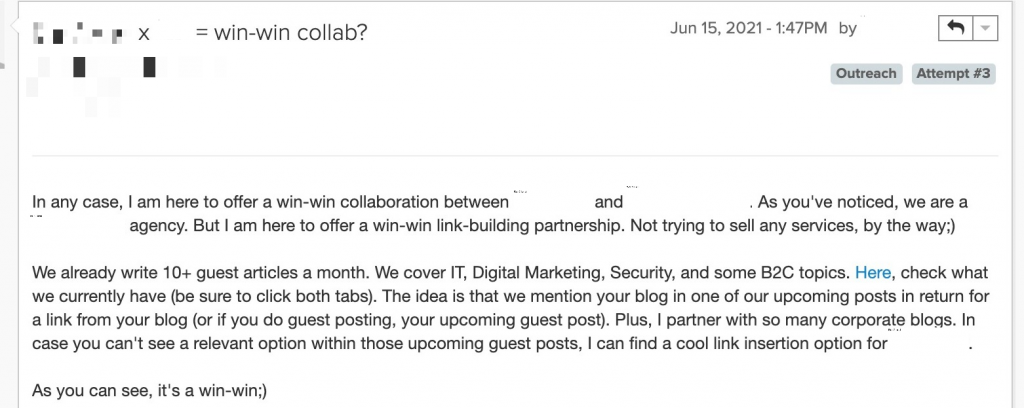
It could help research the person you’re going to reach out to, look through their LinkedIn profile, and the latest posts on their page. It will supply you with a personalized outreach idea to grab their attention.
Strategy #3: Build personal brands inside your company
Employee advocacy can bring awesome perks to your lead generation strategy. When a person within your organization shares valuable insights with their network, it increases your opportunities to find high-quality B2B leads.
These are not just empty words. Statistics show that prospects generated through employee advocacy and social selling are 7 times more likely to buy your product or service. So, don’t disregard your staff’s potential.
How can you use employee advocacy to generate leads?
The most straightforward way is to ask salespeople, marketers, and other team members to share insights on their social media profiles. A more advanced method is to incorporate their presence in your content strategy.
Take Lemlist, for example. The company encouraged its employees to create YouTube channels, where they share marketing tips with the brand’s target audience. For instance, Nadja and Simon from the sales team talk about lead management, building multichannel outreach, etc.:
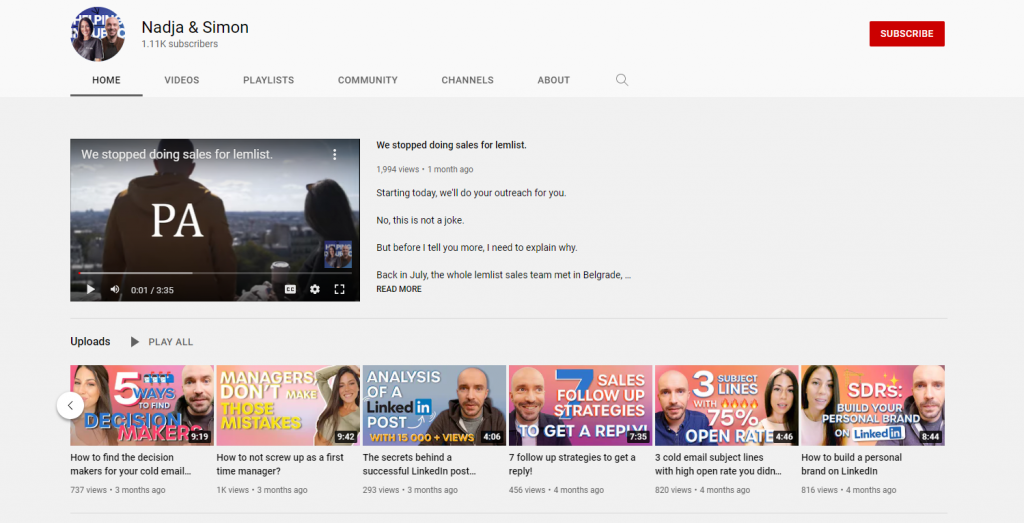
The company’s CEO also has his own YouTube channel and personal website.
What makes Lemlist’s example so unique is that it actually went beyond creating an employee advocacy program and turned its employees into personal brands. Such an approach is more effective as it helps establish a deeper connection between the company and its buyer personas. As a result, you get more quality leads.
Strategy #4: Build a brand
Last but not least, consistent branding is also essential for successful lead generation. It helps represent your business as a whole by making all marketing and sales efforts interconnect and complement each other.
Drift is a great example of how consistency in branding can facilitate growth. Since 2015, this company has been dedicated to establishing a presence in its niche, becoming one of the fastest-developing startups of all time.
One of the key points in branding is creating your own approach to solving your target audience’s pain points. Drift, for instance, coined the categories of conversational marketing and revenue intelligence, which made the brand one of the thought leaders in the chatbot and customer service automation industries.
To bring more prospects, Drift offers various educational resources, including podcasts with influencers, training, case studies, and other inbound lead generation tactics. This way, the company attracts new leads and provides support to the existing buyers, turning them into paying customers.
So, the lesson here is clear – put effort into developing your brand’s voice and strive to be one of the top players in your niche. Indeed, it’s easier said than done, but Rome wasn’t built in one day. Keep a close eye on the market trends, watch your competitors, and develop your own unique presence.
Final Thoughts
B2B lead generation is really not that different – it involves the same strategies, also relies on lead magnets, and aims to bring more prospects to the table.
However, you need to know one thing specific to generating leads for a business – your main task is to build relationships first. Only then can you attempt selling your product.
We’ve reviewed quite a few examples in our guide, but one thing unites them all – they bet on educating the customer and helping them make an informed decision. That’s lead generation in a nutshell – a prospect should be well aware of your product’s potential.
However, lead generation is not the only thing your company should consider when trying to get more prospects. Demand generation also matters as it focuses on targeting marketing qualified leads (MQL). You can learn more about B2B demand generation and MQLs on our blog.

Mariia is a content strategist and editor at Digital Marketer’s World. She is passionate about educating others on all things marketing and believes in the power of the written word.
